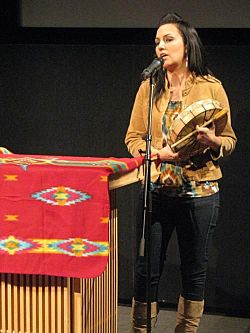Bringing the Circle Together facts for kids
Quick facts for kids Bringing the Circle Together |
|
|---|---|

Felicia Montes performs at Bringing the Circle Together.
|
|
| Genre | Native American, Indigenous, First Nation |
| Dates | Monthly |
| Location(s) | Los Angeles, CA |
| Years active | 2008–2012 |
Bringing the Circle Together was a special film series held in downtown Los Angeles, California. It was all about Native American stories, made by and for Indigenous people. From 2008 to 2012, this series happened every month. It became a really important place for Indigenous communities and their friends to meet. They would talk about important topics, share their history, show off their art, and celebrate their traditions.
The series was led by Lorin Morgan-Richards. He had a lot of help from people like Tahesha Knapp-Christensen, Pamela J. Peters, and Koji Steven Sakai. Lorin also worked with other community leaders. These included Azalea Ryckman, Votan, Corine Fairbanks, Ana Castillo, and Valena Broussard Dismukes.
What Was Shown?
Bringing the Circle Together showed many different films. These movies helped people learn about Native American history and culture. They also highlighted important issues faced by Indigenous communities. After each film, guests would often come to talk. These guests included filmmakers, artists, poets, and community leaders. They shared their experiences and answered questions.
Films and Discussions
The series featured a wide range of films. Some movies explored historical events, like The Buffalo War or Kanehsatake: 270 Years of Resistance. Other films focused on cultural identity, such as Black Indians: An American Story. There were also films that looked at important social issues. For example, In Whose Honor? discussed how Native Americans are shown in sports.
Many screenings included special guests. For instance, after Our Spirits Don't Speak English: Indian Boarding School, guests like Felicia Montes shared their thoughts. This film helped people understand the history of boarding schools. These schools tried to change Native American children's cultures.
In 2009, films like Finding Dawn were shown. This movie brought attention to missing and murdered Indigenous women. Another film, Walk Like a Warrior: The Apache Skateboard Story, showed how skateboarding connects to Apache culture. Filmmakers Douglas Miles and Franck Boistel even came to talk about it.
A special event in 2010 was the screening of Lost Nation: The Ioway. This film led to a historic meeting. Members of the Tongva tribe met with the Southern Ioway and Northern Ioway tribes. It was a chance for different Indigenous groups to connect and share.
The series also partnered with other groups. For example, Two Spirits was shown in partnership with the Red Circle Project. This film explored gender identity within Native American cultures.
The last year of the series, 2012, continued to show important films. For the Rights of All: Ending Jim Crow in Alaska discussed civil rights. American Red and Black: Stories of Afro-Native Identity explored the connections between African American and Native American heritage.
Bringing the Circle Together Magazine
In 2015, Lorin Morgan-Richards created a free magazine. It was also called Bringing the Circle Together Magazine. This magazine featured interviews with important contemporary Native American leaders. Some of the people interviewed included Joanne Shenandoah, Greg Grey Cloud, and L. Frank. The magazine helped continue the conversations started by the film series.
See also
- Pan-Indianism

